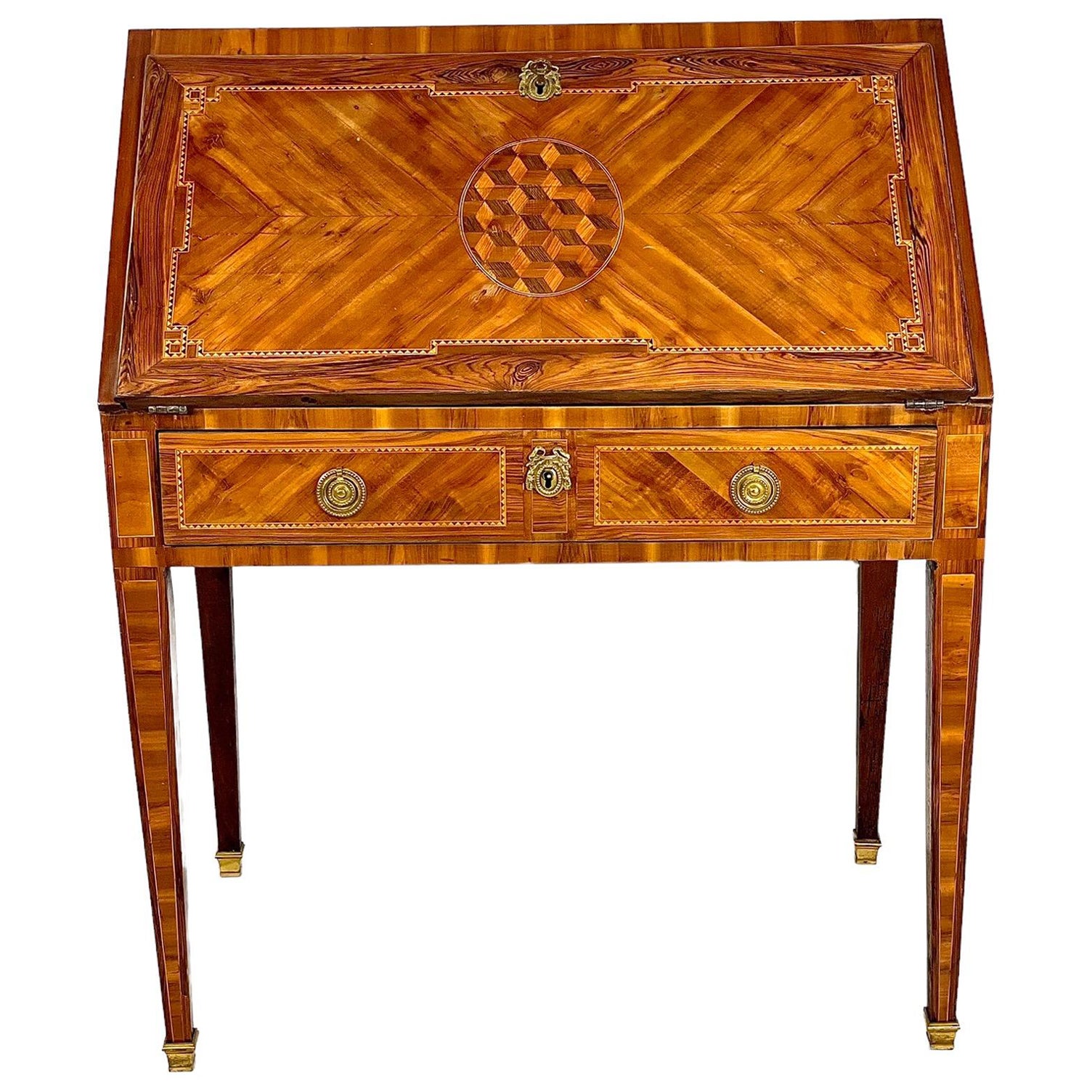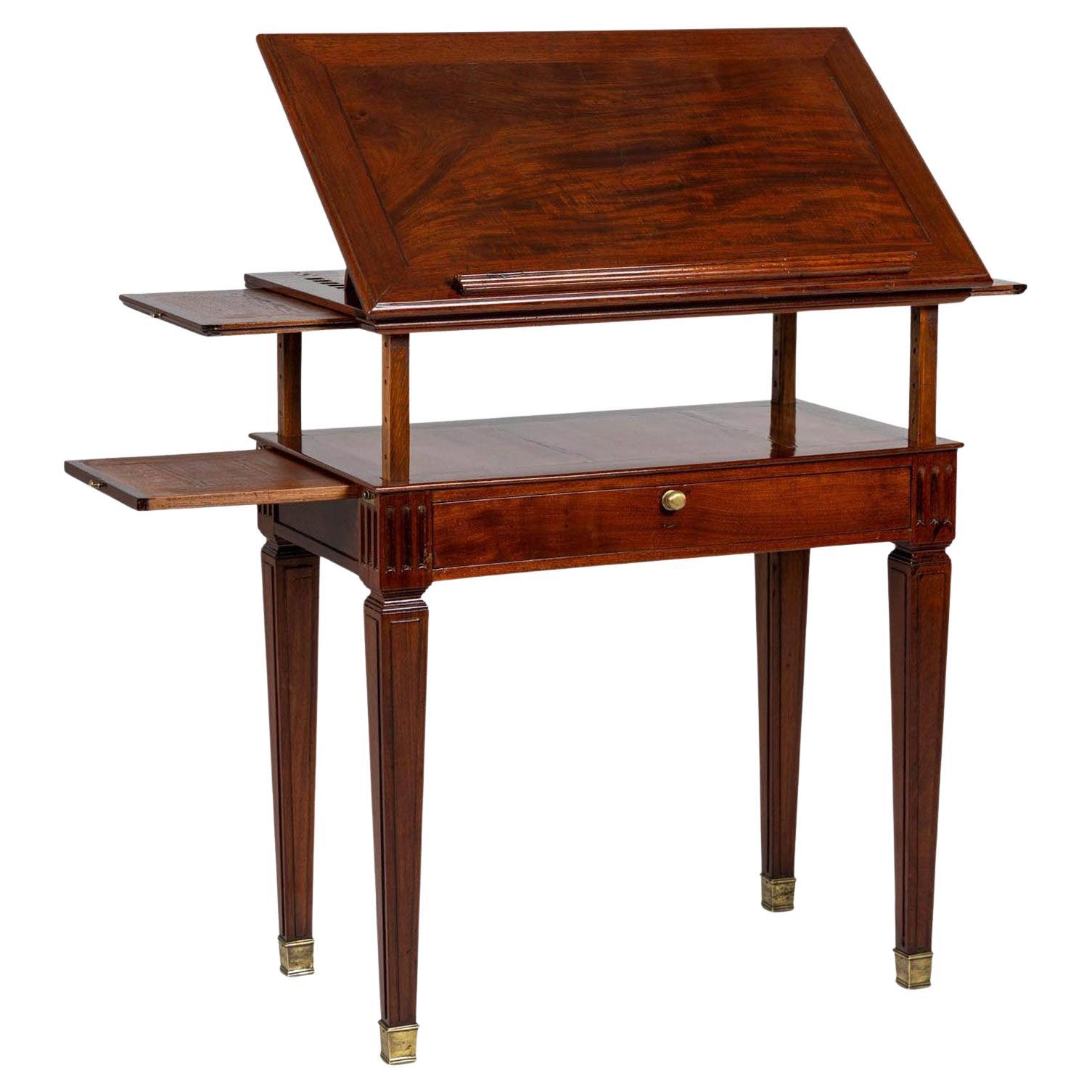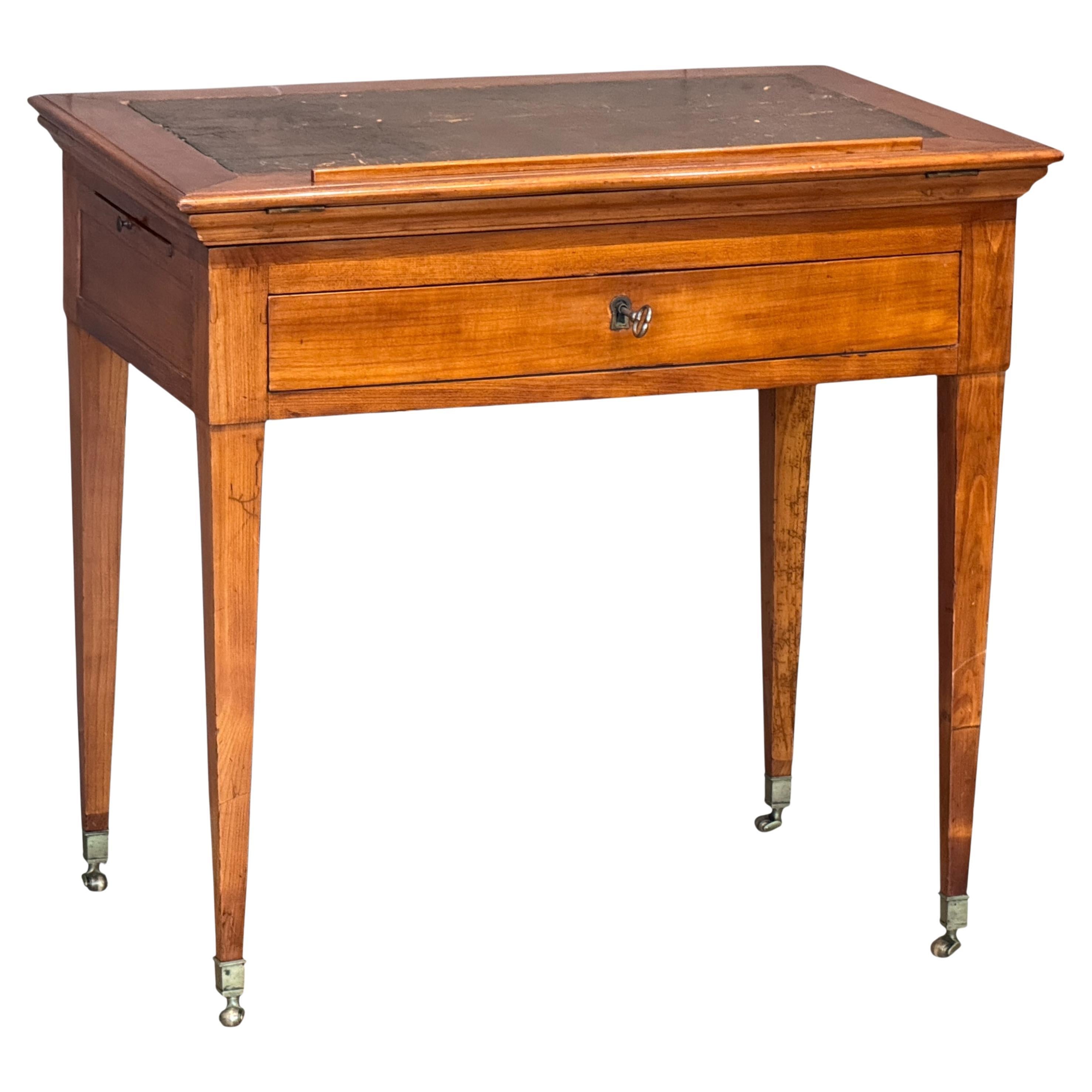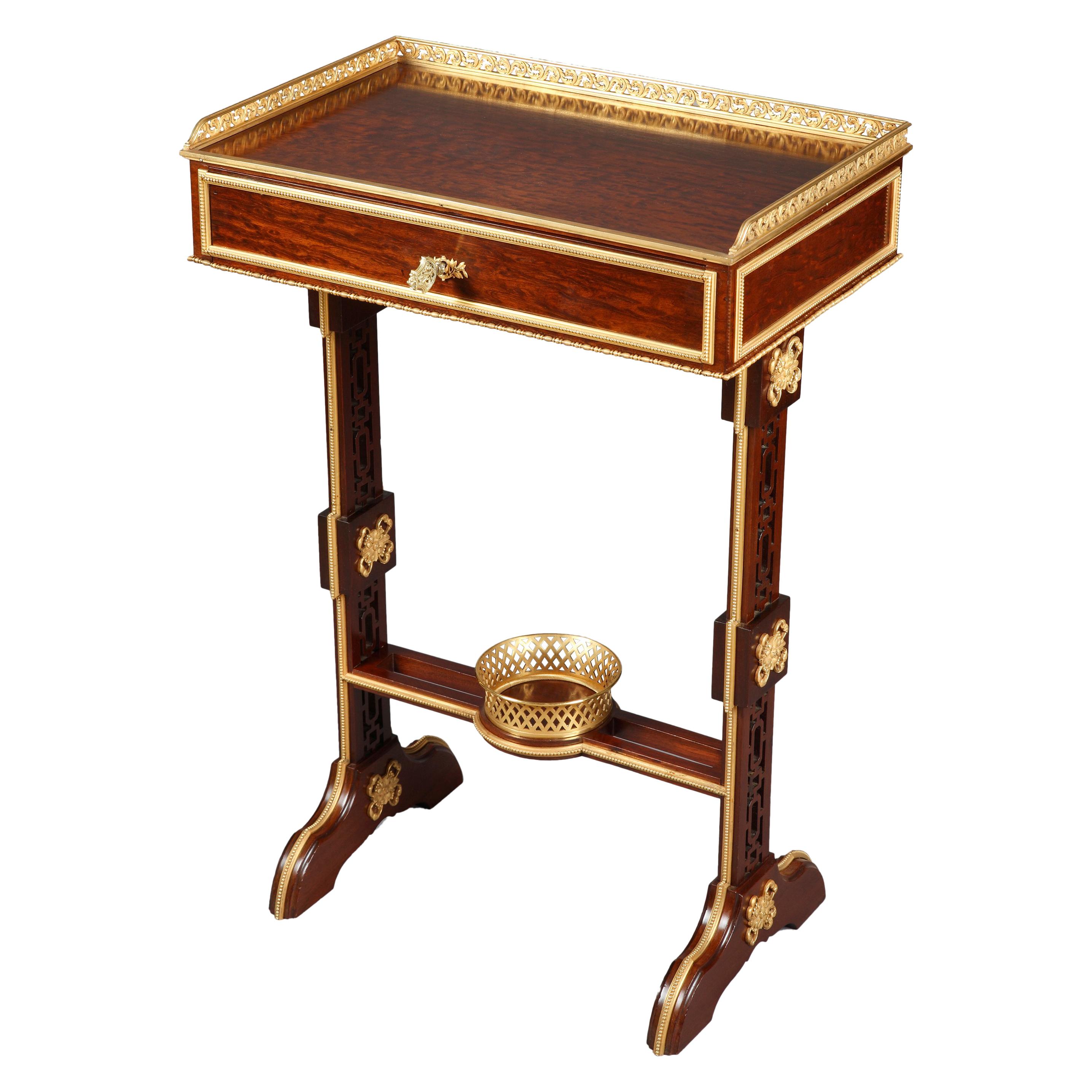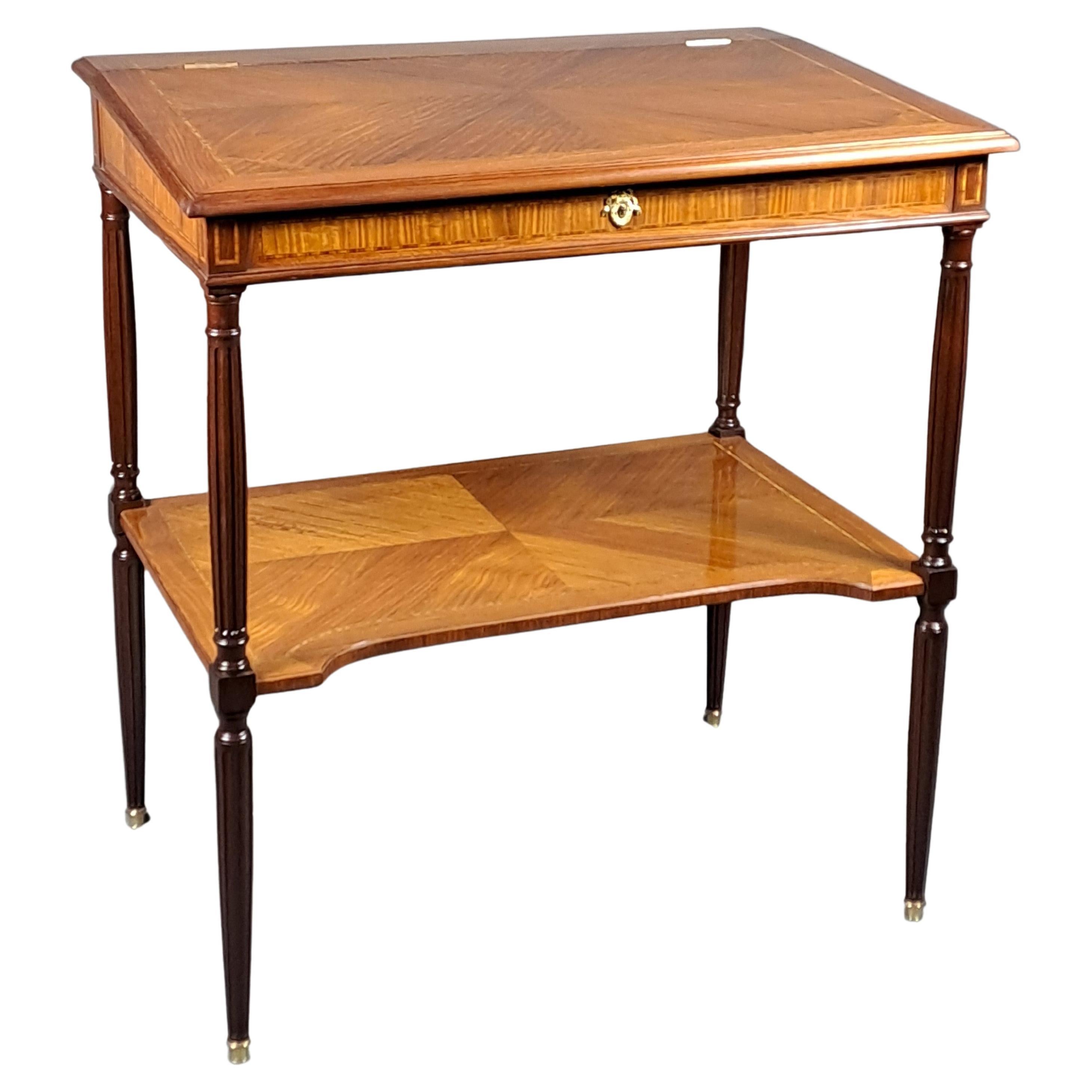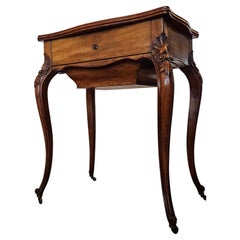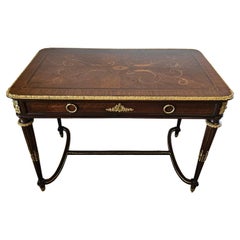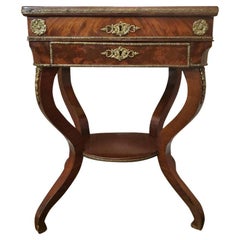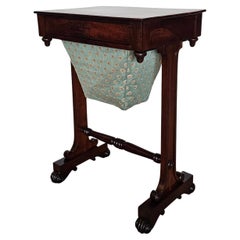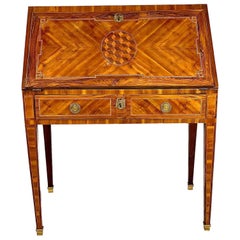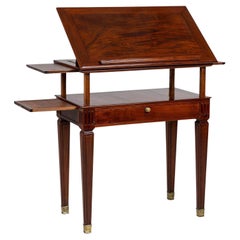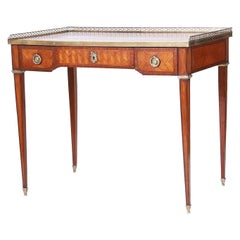Items Similar to Antique Slant-Front Drafting Desk Writing Table
Want more images or videos?
Request additional images or videos from the seller
1 of 9
Antique Slant-Front Drafting Desk Writing Table
$2,500
£1,940.60
€2,201.25
CA$3,569.60
A$3,933.41
CHF 2,040.20
MX$46,782.66
NOK 25,807.90
SEK 24,176.53
DKK 16,440.04
About the Item
A rare and exceptionally inlaid antique slant-front drafting desk. circa 1900
Hand-crafted in the early 20th century, likely French, one piece desk on frame form, having a sloped front with inset felt writing surface garnished with gilt brass flower tacks. The top lifting to reveal open interior storage compartment, gallery with two dovetailed drawers, letter slots and pigeon hole cubbies, brass cartouche shaped escutcheon lacking key, all rising on solid mahogany stretcher joined turned straight legs. Exquisitely inlaid, displaying diamond matched parquetry-work, accented with exotic and precious woods, including richly figured mahogany, rosewood palisander, kingwood, maple and ebony inlaid string work, checkered cross banding and burlwood panels.
Elegant, sophisticated, and refined design, with clean lines and simple silhouette, executed in luxurious exemplary exotic woods, finished on all sides and light weight, allowing it to be placed anywhere in the room and easily moved.
Provenance:
From a very fine private Dallas, Texas estate
Acquisition:
Acquired from highly reputable high-end auction house, Austin Auction Gallery, July 2021 catalog.
Dimensions: (approx)
35" High, 27.75" Wide, 28" Deep
Makes for a wonderful architect's / architectural table, artist drawing board, office work desk, standing desk, engineer's desk, library table, ladies bonheur du jour, lectern, and more
Great original antique condition. Presents well, with nicely aged warm rich dark patina and lustrous sheen. Retaining original antique character and charm throughout. Wear commensurate with well over 100 years of age and use. Strong, sturdy, stable and structurally sound. Overall a wonderful example. Delivered cleaned, hand waxed, polished, ready for immediate use and many, many more years of enjoyment.
Professional white-glove shipping/In-home delivery available. Depending on location please allow up to six to eight weeks for delivery.
Pickup available near Dallas, Texas
- Dimensions:Height: 35 in (88.9 cm)Width: 27.75 in (70.49 cm)Depth: 28 in (71.12 cm)
- Style:Louis XVI (In the Style Of)
- Materials and Techniques:
- Period:
- Date of Manufacture:circa 1900
- Condition:Wear consistent with age and use. Great original antique condition. Presents well. Nicely aged warm rich dark patina & lustrous sheen. Retaining original antique character & charm throughout. Wear commensurate with age & use. Strong, sturdy, stable, structurally sound. Ready for use.
- Seller Location:Forney, TX
- Reference Number:1stDibs: LU5977226124272
About the Seller
4.8
Platinum Seller
Premium sellers with a 4.7+ rating and 24-hour response times
Established in 2013
1stDibs seller since 2021
309 sales on 1stDibs
Typical response time: 1 hour
- ShippingRetrieving quote...Shipping from: Forney, TX
- Return Policy
More From This Seller
View AllAntique French Ledet et fils Louis XV Ladies Sewing Work Table Dressing Vanity
Located in Forney, TX
Refined country French elegance and sophistication at its finest, this Provincial Louis XV style lady's sewing stand work table or coiffeuse by Ledet et fils exudes refined grace and functionality.
Born in Bordeaux Region of Southwestern France in the mid-19th century, exceptionally executed in sophisticated King Louis Fifteenth (1715-1774) taste, hand-crafted of warm mellow solid mahogany, having a rectangular serpentine shaped hinged top opening to reveal the original flat mirror plate, over a removable divided tray, faux drawer front with wooden escutcheon, above a sewing / work bin, gently curved scalloped apron, all rising elegantly on long cabriole legs adorned with finely carved shell acanthus leaf knee ending in whorl feet, terminating on casters. circa 1850s
Signed, retaining the original ébéniste (cabinetmakers) makers mark to the underside, reading:
Ledet
Fab de Meubles
Bordeaux
Dimensions: (approx)
29.25" High, 24" Wide, 16.75" Deep
Versatile:
As warm and attractive as it is useful, having the ideal size and proportions for a variety of different uses, including as a side table, accent table, hall console, sofa table, bedside nightstand, rolling lamp...
Category
Antique Mid-19th Century French Louis XV Side Tables
Materials
Wood, Mahogany
Maison Forest Signed French Louis XVI Style Writing Table - Late 19th Century
By Maison Forest
Located in Forney, TX
A rare and very fine quality 19th century French bureau plat by renowned Parisian ébéniste Maison Forest.
Maison Forest is one of the most famous french cabinetmakers of the 19th a...
Category
Antique Late 19th Century French Louis XVI Desks and Writing Tables
Materials
Bronze, Ormolu
19th C. French Charles X Restoration Period Sewing Stand Work Table
Located in Forney, TX
A scarce period Charles X (1818-1834) French Restoration mahogany travailleuse sewing (thread stand - side table - jewelry dressing table) with light, warm, beautifully aged patina.
Born in France in the early 19th century, almost certainly Parisian work, exquisitely hand-crafted, this exceptionally executed example features ornate gilt bronze ormolu mounts, escutcheons, and elaborate gilt metal trim. Having a highly figured light mahogany hinged lid top, lifting open to reveal a striking finished interior with divided compartments and original inset mirror plate. The conforming rectangular case fitted with a faux drawer front over a dovetailed drawer with sectioned interior. Elegantly rising on oval-shaped medial shelf stretcher-joined curvacious legs.
Dimensions (approx):
27" High, 20" Wide, 13.5" Deep
Stunning light almost blonde antique mahogany coloring and mellow warm tone, superb wood grain detail, and charming, beautifully aged patina over the whole. Great shape overall. Retaining original antique character marks, wear consistent with age and indicative of minimal use, nothing that detracts from the aesthetics or functionality, but only adds to the overall authenticity, refined elegant warmth, luxurious sophistication, and cozy unpretentious rustic elegance.
Delivered cleaned, hand waxed, polished French patina finish, ready for immediate use and generational enjoyment!
What is Charles X style:
The comte d’Artois – or Charles X - was the son of the dauphin Louis-Ferdinand de Franc and Marie-Josèphe de Saxe. He succeeded his two brothers Louis XVI and Louis XVIII and became the King of France in 1824. Thirty years after the French Revolution, he wanted to embody the return of monarchy and became the leader of the catholic party . As the previous kings, he was crowned in 1825 but he was soon overthrown by the revolution in July, 1830, called "Trois Glorieuses". He left then for England, Scotland, Prague and Istria where he died in 1836.
Charles X style lasted from 1818 to 1834 and happened during the Bourbon Restoration (French Restoration). This style did not replace totally the style of furniture from the French Empire but it was different from the formalism in the Napoleonic era, during which strictness and simplicity were inspired by Greco-Roman art. Indeed, artistic fields flourished. In terms of furniture, this renewal was suggested by the softening of shapes. Even though the simple aspect from the French Empire was still visible, shapes became curvier with volutes and arabesques. Another distinction is the loss of the massive aspect of furniture and the decrease of dimensions in order to decorate smaller appartments. Handling ability and comfort were key-words in the making of furniture. Apartments had essential elements such as chests of drawers, big rounded tables in the dining room, desks or secretaries, armoires and even dressing tables, comfortable fainting couches in the living room, small tables, pedestal tables, as well as gondola chairs. The wavy aspect of the latters certainly represent Charles X style the best.
One of the most emblematic features of this style is the use of bois clairs – light woods in warm blond tones - and indigenous woods that are varnished in order to highlight the grains. Bird's-eye maple, ash trees, plane trees, yew trees, beech trees, olive trees and cedar trees were most likely to be used. Indeed, at the beginning of the 19th century dark woods were hard to find. In 1806, the Napoleon’s Continental System was established in order to ruin the United Kingdom by preventing the country from any business with the rest of Europe. Therefore craftsmen had to find alternatives from mahogany which was the most commonly used material at this time. After 1815, the import of wood was even more difficult because of peace treaties and the European political situation, which contributed to the popularity of the bois clairs and indigenous woods. The furniture was often decorated with fine inlays made out of dark wood representing foliage, which contrasted with the veneer. Even though these patterns can look like bronze decorations from the Empire era, they were far more simple and did not represent any military or mythological attributes. On the tables, trays were sometimes made out of marble as in the French Empire, but it was often put aside and inlaid veneer, Verre Eglomisé – a type of glass with a mirror finish –, mirror or porcelain from Sèvres or Paris were more likely to be used.
Decorative elements from the Monarchy were highly appreciated again as they suggested luxury. Indeed, marquetry work was particularly fashionable - Boulle marquetry thrived around 1820 as the works of the Levasseur family can show. In the same way, draperies and trimmings referred to the monarchist splendour. Fabrics were often white – the traditional colour of the Bourbons – or light coloured as oppposed to the typical green from the Napoleonic era.
One of the most symbolic figures from this period of time might be Jean-Jacques Werner (1791-1849), a cabinetmaker who worked for prestigious clients such as the Duchesse de Berry who was Charles’s step-daughter. His works can be seen at the Musée des Arts Décoratifs and at the Grand Trianon in the Palace of Versailles. The duchess’s appartments situated at the pavillon de Marsan and at the Palais de Saint Cloud illustrate Charles X style the best with furniture made out of bois clairs and ornamented with dark wood patterns or fine gold decorations.
Chales X style allows a transition between the sobriety of the Empire style and the abundant aspect of Louis-Philippe style. The gothic style started at this time through the "style à la cathédrale", inspired by religious architecture, which thrived from 1827 to 1830. Indeed, at the beginning of the 19th century, Romanticism put the spotlight on the Middle Ages. Cabinetmakers were not inspired by the medieval furniture but rather by architectural elements of churches and cathedrals. For instance the backs of chairs were decorated with arches shaped like rib and serration. In the same way, before Charles X abdicated, pieces of furniture were made out of dark woods – such as mahogany, which was used again in France – and were inlaid with light wood. Romanticism also influenced the layout of furniture in appartments to suggest movement through a mix of various styles, various shapes and various sizes, as opposed to the static aspect of Neoclassicism. The start of industrialisation and mechanisation also influenced this style as early technical developments led to the production of pieces of furniture in series.
Credit:
Marc Maison
Bibliography:
FANIEL Stéphane (Dir.), Le Dix-neuvième Siècle Français, Collection Connaissance des Arts, 1957, Hachette
SASSONE, Adriana Boidi, Furniture from Rococo to Art Deco, 2000, Evergreen
--
Extremely versatile:
As warm and attractive as it is useful, this remarkable antique table having the ideal size and small proportions for a variety of different uses, including as a side table, accent or occasional table, tall sofa...
Category
Antique Early 19th Century French Charles X End Tables
Materials
Bronze, Ormolu
William IV Period English Sewing Stand Work Table
Located in Forney, TX
A scarce nearly 200 year old English William IV Period rosewood and mahogany sewing stand work table with beautifully aged warm rustic patina. circa 1830s
Combining sophisticated e...
Category
Antique Mid-19th Century English William IV Side Tables
Materials
Fabric, Upholstery, Mahogany, Rosewood
Antique French Louis XVI Bronze Mounted Writing Table
By François Linke, Claude Michel Clodion, Jean-Henri Riesener
Located in Forney, TX
A striking French antique Louis XVI style gilt bronze mounted writing table made after the model by cabinetmaker to King Louis XVI and Marie Antoinetteean, important ébéniste Jean-Henri Riesener (German/French, 1734-1806) and later reproduced by Francois Linke (French, 1855-1946). Signed bronze mounts, Marco.
Born in France in the early 19th century, possibly during the late 18th century Louis XVI period, most likely Parisian work, exquisitely hand-crafted in several woods of contrasting colors including walnut and mahogany to create fine wooden inlays and parquetry detailing. The original partially inset marble top with dramatic veining sits above a flat sided break-fronted front and back adorned with fine bas-relief bronze plaques cast adorned with putti cherubs in the manner of the French sculptor Clodion (Claude Michel, 1738-1814).
The centered front bronze panel disguises a single frieze drawer with dovetail joinery and original key, flanked by gilded bronze foliate mounted rounded corners, a simulated panel drawer to the reverse, embellished on all four sides by intricate finely chiseled, chased and sculpted scrolling laurel ribbon and garland swag ormolu mounts, patinated brass running ornamentation, rising elegantly on four bronze dore ring mounted straight tapering fluted legs, terminating in patinated bronze toupie feet sabots. Signed / marks; the bronzes are stamped / incised Marco.
PROVENANCE / ACQUISITION:
Property from the Collection of Gloria Monnet Nicholson, Tulsa, Oklahoma.
Acquired from highly reputable auction house Heritage Auctions, Dallas, Texas. Fine Furniture & Decorative Arts Signature Auction, catalog #8085.
Dimensions: (approx)
30" High, 32" Wide 21.5" Deep
As warm and attractive as it is useful, having the ideal size and proportions for a variety of different uses, including as a side table, petite bureau...
Category
Antique Early 19th Century French Louis XVI Desks and Writing Tables
Materials
Marble, Brass, Bronze
Early 20th Century French Louis XVI Mahogany Leather Top Bureau Plat
Located in Forney, TX
An antique Louis XVI style writing desk with beautiful patina. Hand crafted in France in the early 20th century, featuring a rich mahogany finish adorned with gilt bronze ormolu moun...
Category
Early 20th Century French Louis XVI Desks and Writing Tables
Materials
Bronze, Ormolu
You May Also Like
18th Century Louis XVI Period Fall Front Desk
Located in LA CIOTAT, FR
This elegant writing desk, known quirkily as a “bureau à dos d’âne” (donkey’s back desk), is beautifully veneered in rosewood, including reverse diamonds and butterfly-wings, which a...
Category
Antique 18th Century French Louis XVI Desks
Materials
Bronze
High Adjustable Architect's Desk, Writing Desk, circa 1800
Located in Greven, DE
Antique height-adjustable desk, architect's table, around 1800
France
Mahogany
circa 1800
Dimensions: H x W x D: 78 x 84 x 50
Height-adjustable to approx. 120 cm, can be folded up...
Category
Antique Early 1800s French Louis XVI Desks and Writing Tables
Materials
Mahogany
Antique French Louis XVI Style Leather Top Writing Desk
Located in Palm Beach, FL
Refined antique French Louis XVI style writing desk crafted in exotic tulipwood veneer with crossbanding and chevron designs, having a tooled leather top with a brass gallery, the ca...
Category
Early 20th Century French Louis XVI Desks and Writing Tables
Materials
Brass
Louis XVI French Fruitwood Architect’s Table
Located in Charlottesville, VA
A Louis XVI period French architect’s table in fruitwood with an adjustable leather-inset drafting top. The table features a single drawer, slide-out candle supports, and classic tap...
Category
Antique Late 18th Century French Louis XVI Desks and Writing Tables
Materials
Metal
Beautiful Louis XVI Style Writing Table, France, Circa 1880
Located in PARIS, FR
Beautiful Louis XVI style wooden writing table. The rectangular top, surrounded on three sides by a fine pierced and gilt-bronze frieze, above a d...
Category
Antique 1880s French Louis XVI Desks and Writing Tables
Materials
Bronze
Large Notary Writing Desk Louis XVI Style
Located in BARSAC, FR
Rare Louis XVI style notary writing desk made of mahogany frieze marquetry and light wood and rosewood fillet friezes.
Four solid mahogany fluted legs joined by a spacer shelf.
Fre...
Category
Antique Late 19th Century French Louis XVI Desks
Materials
Mahogany
More Ways To Browse
Writing Slant
Side Table Turned Legs Cross Stretcher
Draft Table
Drafting Tables
Inlay Table Burl
Drafting Tables
Antique Veneer Desks
Drafting Desk
Table Lectern
Antique Drawing Desk
Drafting Desk Antique
French Bonheur Du Jour Side Table
Antique Drafting Table Desks
Engineer Desk
Architects Drawing Table
Antique Walnut Writing Bureau
French Executive Desk
Modern Library Table
